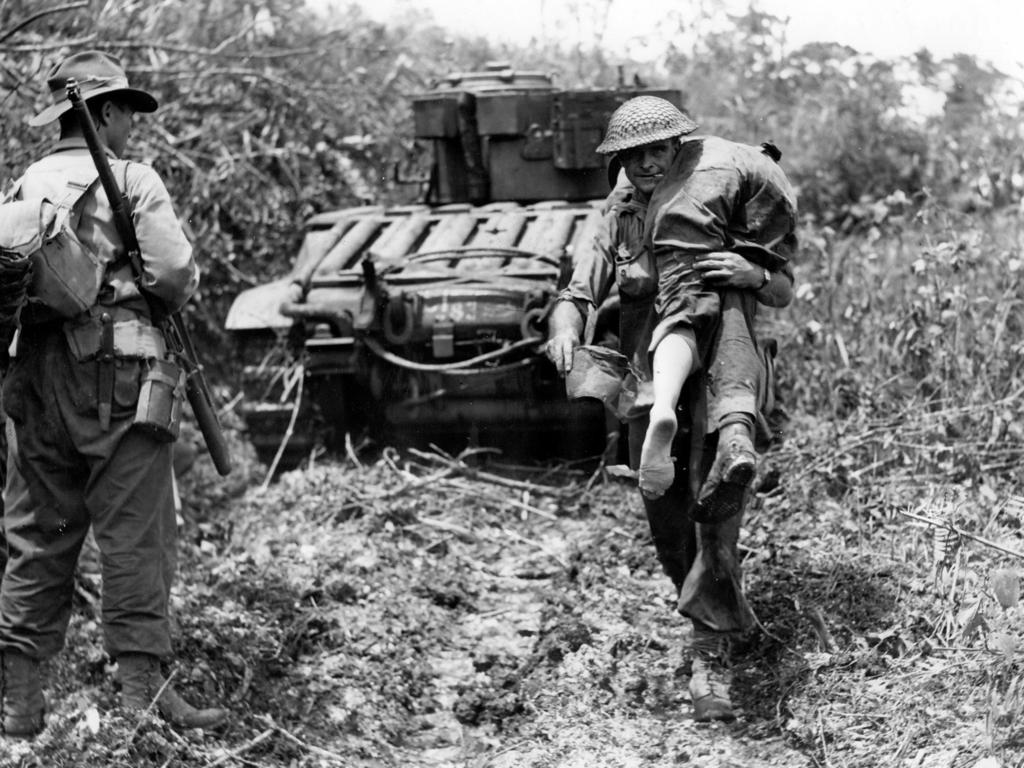Thomas “Diver” Derrick was awarded a VC after he destroyed six enemy posts to help capture Sattelberg
A TINY village at the top of a hill became a Japanese stronghold that was captured with the help of the VC winning bravery of Thomas Derrick
THE tiny mountain village of Sattelberg surrounded a mission school at the top of a hill, but its position made it strategically important.
It allowed Japanese soldiers in New Guinea to control the commanding heights north of Finschhafen on the Huon Peninsula.
Australian and American troops had captured Finschhafen in September 1943 but they came under attack from Japanese troops entrenched on the ridge at Sattelberg and surrounding areas. Hearing that the Japanese were planning a major assault, Maj-Gen George Wootten decided to capture the town, a daunting task that would require an uphill assault directly in the line of
fire of Japanese machine guns.
After a month of building up supplies and getting his troops into a position to attack, 75 years ago today Wootten launched a preliminary assault to capture Green Ridge on the Sattelberg road on November 16, 1943.
It was the start of a gruelling battle that would earn Sgt Thomas Currie Derrick the Victoria Cross.

In the days before the assault, engineers had bulldozed a path for Matilda tanks to make their way up the hill. On November 17 the main assault began with an artillery barrage to mask the noise of the tanks as they rolled forward. But the advance, hampered by thick jungle and steep ridges, was soon slowed by Japanese machine guns, mortars and grenades.
The Japanese had also planted explosive devices, which damaged one of the tanks and halted the advance. Repairs were undertaken and the advance was resumed the next day.
But as the tanks rolled the next day, the Japanese became increasingly desperate as their supplies ran low. On November 21, the Japanese launched a counteroffensive that allowed them to withdraw to a stronger position.
On November 22 the tanks were held up by landslides caused by Japanese grenades, so smaller units made assaults and fought their way closer to the summit. Allied bombers tried to dislodge the Japanese but they still clung on.
Then, on November 24, when the order was given to withdraw, Sgt Derrick asked to make one more attempt to reach the summit. Born in Adelaide in 1914, Derrick had been a keen swimmer as a child earning the nickname “Diver” Derrick. He tried a range of jobs including carpentry but he was a manager on a fruit farm before signing up for the army in WWII in 1940. Derrick served at Tobruk, earning a Distinguished Conduct Medal in Syria, before
being wounded at El Alamein.


Promoted to sergeant he was already something of a legend before he was sent to New Guinea in 1943. After all he had been through he wasn’t going to let this hill defeat him.
With his platoon Derrick scrambled up the steep slope destroying a Japanese post with grenades he tossed into their dugout, enabling his troops to move further forward.
Coming under intense fire, Derrick continued to hurling his grenades, forcing the Japanese to withdraw. He kept moving forward, attacking a post, then laying flat against the slope to avoid fire. In total he took out six enemy posts. Suddenly there was less gunfire coming from the summit. As night fell, Derrick and his men dug in, waiting to finish the climb to the top the next day.
At dawn it became apparent that the Japanese had abandoned Sattelberg. Derrick planted an Australian flag, his action captured by photographers. The capture of Sattelberg enabled the Allies to secure their hold over Finschhafen and surrounding areas, in preparation for finally clearing the remaining few thousand Japanese.

Derrick was awarded a Victoria Cross for his action at Sattelberg and then returned to Australia where he was sent to an officer cadet training unit, earning his commission as
a lieutenant in November 1944.
Ordinarily it was forbidden for an officer who had just earnt his commission to return to serve in the unit he had served in before becoming an officer but he was given special dispensation to rejoin the 2/48th battalion on Morotai in 1945.
However, in May 1945 while he was leading his men in another assault on Japanese troops dug in at the top of a hill, he was badly wounded. Evacuated to a hospital, he died the next day.



